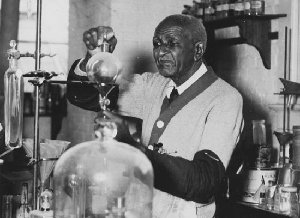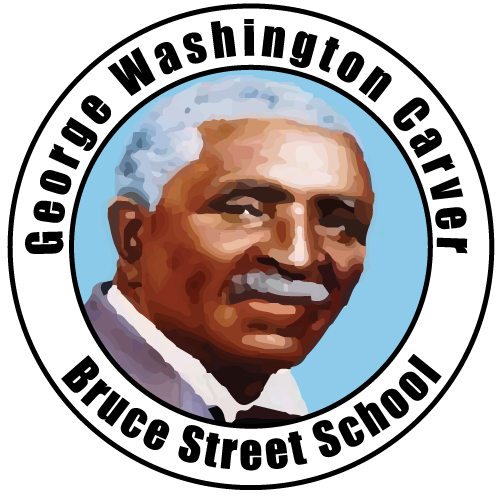George Washington Carver

George Washington Carver started his life as a slave and worked his way to becoming a respected and world-renowned agricultural chemist. He helped develop agricultural techniques used around the world.
Early Years
George Washington Carver was born in Kansas Territory near Diamond Grove, Missouri, during the bloody struggle between free-soilers and slaveholders. His father, a slave on a nearby farm, was killed shortly before Carver was born. Carver himself became the kidnap victim of night riders while still a baby. With his mother and brother, James, he was held for ransom. Before they were rescued, his mother died. Moses Carver, a German farmer, ransomed (traded) the infant Carver for a $300 race-horse. Thus he was orphaned and left in the custody of a white guardian from early childhood.
Carver was a talented student, but even his talents could not overcome racism (feelings of racial superiority). He was not allowed to attend the local schools because of his color. Instead, Carver had responsibility for his own education. His first school was in Neosho, Kansas. Neosho had once been a Confederate capital. Now it had become the site of the Lincoln School for African American children, a school for black children some nine miles from Carver's home. Every day Carver walked there with his brother James. His first teacher was Stephen S. Frost, an African American. Carver and his brother faithfully went to school for several years. Finally James, tired of formal schooling, quit to become a house painter, but not George. George Washington Carver. Reproduced by permission of Fisk University Library.
He continued until he was seventeen. Then he went on to complete his high school work in Minneapolis, Kansas, and finally graduated in his mid-twenties. At the time Carver had wished to become an artist. His sketch of the rose Yucca Gloriosa won him a first prize at the World's Columbian Exposition in 1893.
An Agricultural Education
Carver applied to study at the Iowa State College of Agricultural and Mechanical Arts, but he was turned down when it was learned that he was of African heritage. He then applied to Simpson College at Indianola, Iowa, where he was the second African American to be admitted. Tuition was $12 a year, but it was hard to come by even this small amount. Carver worked as a cook at a hotel in Winterset, Iowa, to raise the money.
After attending Simpson College for three years, he once again applied for admission to Iowa State. He was admitted and was placed in charge of the greenhouse of the horticultural department while doing graduate work. Carver quickly won the respect and admiration of the faculty and student body. He earned his master's degree in agriculture in 1896, and, by the time he left, Carver was an expert at mycology (the study of fungi) and plant cross-fertilization.
A Career Begins
In April 1896 Carver received a unique offer from the African American educator Booker T. Washington (1856–1915) to teach at Tuskegee Institute in Alabama. Said Washington: "I cannot offer you money, position or fame. The first two you have. The last from the position you now occupy you will no doubt achieve. These things I now ask you to give up. I offer you in their place: work—hard, hard work, the task of bringing a people from degradation, poverty, and waste to full manhood. Your department exists only on paper and your laboratory will have to be in your head."
Carver accepted the challenge. He arrived at the tiny railroad station at Chehaw, Alabama, on October 8, 1896. In a report to Washington he wrote: "8:00 to 9:00 A.M. , Agricultural Chemistry; 9:20 to 10:00 A.M. , the Foundation of Colors (for painters); 10:00 to 11:00 A.M. , a class of farmers. Additional hours in the afternoon. In addition I must oversee and rather imperfectly supervise seven industrial classes, scattered here and there over the grounds. I must test all seeds, examine all fertilizers, based upon an examination of soils in different plots."
Through the years Carver gained a national, as well as an international, reputation. Chinese and Japanese farmers raised many unique problems for him. Questions were referred to him from Russia, India, Europe, and South America. He later had to turn down a request to journey to the Soviet Union, the country that once consisted of Russia and other smaller nations. In 1916 he was elected a member of the Royal Society for the Encouragement of Arts in England, the world's oldest scientific organization. Later, in 1918, he went to the War Department in Washington, D.C., to demonstrate his findings on the sweet potato. He was awarded the Spingarn Medal of the National Association for the Advancement of Colored People (NAACP) in 1923.
The personality of Carver
An early close friend of Carver was Henry A. Wallace; the pair knew each other for forty-seven years. Wallace said that Carver often took him on botanical (relating to plants) expeditions, and it was he who first introduced Wallace to the mysteries of plant fertilizers. Carver was a shy and modest bachelor, an unmarried man. An attack of whooping cough (a contagious disease that attacks the respiratory system) as a child had permanently caused him to have a high-pitched tenor voice. He considered it a high duty to attend classes and was seldom absent. In 1908 he returned to the West to visit his ninety-six-year-old guardian, Moses Carver, and to visit the grave of his brother, James, in Missouri.
A careful and modest scientist, Carver was not without a sense of humor. When one of his students, hoping to play a trick on him, showed him a bug with the wings of a fly and the body of a mosquito, Carver was quick to label it "a humbug."
Developments and World Fame
Carver utilized the materials at hand. He was interested in crop rotation and soil conservation. From the clay soil of Alabama he extracted a full range of dyestuffs, including a brilliant blue. He created sixty products from the pecan. From the common sweet potato he developed a cereal coffee, a shoe polish, paste, oils—about one hundred products. From the peanut he came up with over 145 products. Carver suggested peanuts, pecans, and sweet potatoes replace cotton as money crops. He published all of his findings in a series of nearly fifty bulletins.
The testimony of Carver before the congressional House Ways and Means Committee in 1921 led to the passage of the Fordney-McCumber Tariff Bill of 1922. Scheduled to speak a short ten minutes, he was granted several time extensions because of the intense interest in his presentation. At the lecture he appeared in a greenish-blue suit many seasons old, having refused to invest in a new suit and announced, "They want to hear what I have to say; they will not be interested in how I look."
In 1935 Carver was chosen to work with the Bureau of Plant Industry of the U.S. Department of Agriculture. He received the Theodore Roosevelt Medal in 1939 for distinguished achievement in science. During his lifetime Carver had made many friends. Automobile manufacturer Henry Ford (1863– 1947) was his frequent host. Carver was also a treasured friend of inventor Thomas A. Edison (1847–1931). It was Edison who offered to make him independent with his own laboratories and an annual stipend (fixed payment) of $50 thousand. Other famous friends included horticulturist Luther Burbank (1849–1926), industrialist Harvey Firestone (1868–1938), and naturalist John Burroughs (1837–1921). He was also a friend of three presidents: Theodore Roosevelt (1858–1919), Calvin Coolidge (1872–1933), and Franklin Delano Roosevelt (1882–1945).
Carver had earned the salary of $125 a month from the beginning until the end of his service at Tuskegee Institute, which spanned forty-six years. He might have had much more. In 1940 he gave his life savings, $33 thousand, to establish the George Washington Carver Foundation at Tuskegee Institute to continue research in agriculture and chemistry. He later left his entire estate to the foundation, a total of about $60 thousand. He died on January 5, 1943.
At the dedication of a building in his honor at Simpson College, Ralph Bunche (1904–1971), a Nobel Prize winner, pronounced Carver to be "the least imposing celebrity the world has ever known." Carver's birthplace was made a national monument on July 14, 1953.
Read more: George Washington Carver Biography
Here is a List of George Washington Carver's Inventions:
| Beverages | Cosmetics | Dyes, Paints & Stains |
|
|
|
| Stock Foods | Medicines | General |
|
|
|
| Foods | ||
|
|
|
